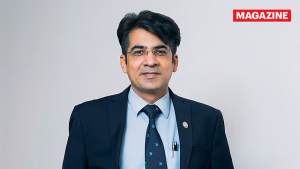GABRIEL INDIA , the flagship company of the $2.2-billion Anand Group, has been on expansion mode. The shock-absorber maker, which produces auto components for ride-control, was the first mover in India’s electric scooter space, and currently accounts for over half of the electric two-wheeler market. As demand for feature-rich cars increased, the company latched on to the premiumisation trend by entering into a joint venture with Dutch sunroof maker Inalfa Roof Systems.
Gabriel India began manufacturing shock absorbers and front forks for two- and three-wheelers in the 1990s. It is now among the Top 3 players in the two-wheeler segment, and the market leader in three-wheelers. From a single product, suspension systems, it has transitioned into a multi-product company by foraying into sunroofs. According to Elara Capital, sunroof penetration of the PV market is set to increase to 40% by FY27, from the current 25%.
Earlier this year, Gabriel strengthened its position in the suspensions market with the strategic acquisition of assets of Marelli Motherson Auto Suspension Parts, a Pune-based joint venture between Marelli Europe and Motherson International. The move is expected to give Gabriel an additional production capacity of 3.2 million shock absorbers and 1 million gas spring units, a new product line that has long been part of the firm’s strategic vision.
“This acquisition will improve our position in the suspensions market, enhance capabilities and expand the product portfolio, which will help us drive our growth trajectory,” Atul Jaggi, MD, Gabriel India, said in an analyst call after the company’s Q3 earnings.
Gabriel also has a technology assistance agreement with Marelli Suspension Systems Italy, to boost its advanced suspension offerings for future OEM requirements. But the turnaround of Marelli Motherson Auto Suspension Parts is not going to be a cakewalk. MMASP reported net losses in FY23 and FY24, and its dependence on top customer remains high at about 50% of total sales in FY24, exposing it to customer concentration risk, according to ICRA.
“There are clear synergies on the product side from the acquisition of assets of Marelli Motherson Auto Suspension Parts . There is a very similar product line and customer portfolio. The gas spring product is a new line for us which we always wanted to enter into. The customer portfolio is quite good with Tata , Maruti and Renault being the Top 3 customers,” Jaggi said.
Gabriel’s PV market share stood at around 23% in FY24, compared with 15% in FY20, according to a note by Elara Capital. The increase in market share was primarily driven by increased penetration of SUVs from around 35% in FY20 to 60% in FY24. “Its SUV share in the PV business is around 64%, which underscores Gabriel’s proactive approach toward cashing in on the SUV trend. The company caters to major OEMs such as Maruti Suzuki India , Volkswagen and M&M , and is making steady inroads with Tata Motors and Stellantis,” the note says.
In electric two-wheelers, with a dominant market share of over 50% in the EV space, Gabriel serves all major models, including those from Ola Electric , Ather Energy, and TVS Motor Company . Its EV sales now comprise 9% of total sales, up from 3% last year, according to Geojit Financial Services. The brokerage, however, expects Gabriel’s EV order book to be “normal” for the year due to the reduction in subsidy and high scrutiny by the government on availing PLI benefits. In addition, weakness in Europe is likely to continue for a longer period. “Gabriel’s expansion in the EV space will support volume growth in the long run with the new strategy and subsidiary ‘ANEVOLVE’ EV, which aims to expand EV products through partnerships.”
The auto parts maker’s partnership with Dutch sunroof manufacturing firm Inalfa has led to expansion in the export mix. In the last nine months, the JV has given a top-line growth of 10-12%. Consolidated revenue, meanwhile, has grown 24% year-on-year in Q3FY25. “Our diversification into the sunroof segment shows Gabriel’s commitment to become a comprehensive solution provider to the automotive industry beyond our product portfolio,” Anjali Singh, executive chairperson of Gabriel India, said in its FY24 annual report.
In Q3FY25, Inalfa Gabriel Sunroof Systems reported revenue from operations of ₹92 crore and PAT margin of 6.7%. “The sunroof business continues to experience strong demand primarily due to rising volumes, customer preference for the sunroof product, and new vehicle launches. Our well-timed entry has helped us strategically, and we are set to double the capacity by CY25 to meet growing customer demand,” Jaggi said during the analyst call. The firm expects to reach full utilisation for the second phase of its capacity by end-2026 (400,000 units).
In FY24, Gabriel achieved a net income of ₹3,403 crore. Earnings before interest, taxes, depreciation and amortisation (Ebitda) grew 37.1% YoY to ₹293 crore. The company is No. 6 on Fortune India’s 100 Emerging Stars list.
“As the auto industry shifts towards electric mobility, Gabriel has engaged with leading two- and three-wheeler EV companies. This engagement has enabled Gabriel to establish a strong presence in the two-wheeler segment,” Singh said in the annual report. “We are aware of changing auto sector preferences. We see future opportunities in areas beyond suspension systems…”
The sunroof plant at Chennai commenced operations in January 2024 with a capacity of 200,000 units per annum. It caters to Hyundai Motor India and Kia India. To meet rising demand, Gabriel has announced plans for further expansion, aiming to double capacity to 400,000 units per annum by FY26.
On the EV side, the industry is in a transition phase, said Jaggi. “While penetration continues, the replacement of FAME with the PM E-Drive programme has reduced direct subsidies per vehicle, leading to the decline in overall two-wheeler volumes… While volumes have grown on an annualised basis, we are seeing month-on-month decline in the last couple of months.”
According to Elara, inefficient capital allocation towards a new product strategy may drag return ratios for Gabriel. It has also flagged profitability issues owing to increased competition and pricing pressures from OEMs. Anand Rathi, on the other hand, cites less-than-expected growth in underlying segments, slower traction in new product lines, and adverse commodity movement among key risks.
But then the silver lining is that Gabriel doesn’t have to worry too much about U.S. auto tariffs as it mainly plays in the domestic market with the bulk of its revenue (64%) coming from two- and three-wheelers. Exports contribute 3-4%.
The company’s management is looking to expand its CV business overseas, according to a note by brokerage firm Sharekhan. It expects faster growth in aftermarket and export segments, among key differentiators for the company that aims to be among the Top 5 global manufacturers of shock absorbers.
And all this comes at a time when a NITI Aayog report forecasts India’s automotive component production to hit $145 billion by FY30 from $70 billion in FY23, with auto component exports tripling to $60 billion.


